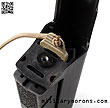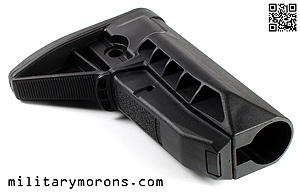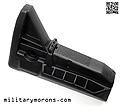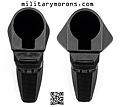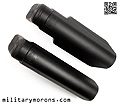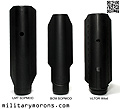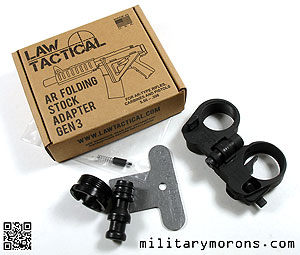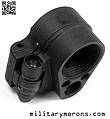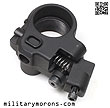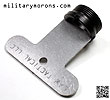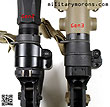AR15 Furniture Page 1 Page 2 Page 3 Page 4 Page 5
TO VIEW FULL SIZE IMAGES: USERNAME and PASSWORD are both "mm"
10/26/14 - The BCMGUNFIGHTER Stock from Bravo Company USA is finally hitting the market after months of testing and development. BCM touts it as the "strongest light-weight polymer stock available for mil-spec receiver extensions" at the time of release; setting a new industry standard for the combination of light weight and strength in a carbine stock. Description - It was only a matter of time before BCM came out with their own Stock, to match their ever-expanding line of AR accessories. Designed by Eric Kincel and the BCM R&D team, the BCM Gunfighter stock has a unique profile that's devoid of any sharp edges or latches that could possibly snag or catch on anything. From the outside, it looks bulkier than more skeletonized designs like the Vltor IMod or Magpul CTR pictured here, but it's lighter than either of them at less than half a pound. Rather than having a locking lever that protrudes from the body of the stock, the BCM Gunfighter's lever forms the entire forward bottom of the stock. It's an aesthetic that doesn't appeal to everybody at the outset, but is makes perfect sense functionally. The BCM Gunfighter stock is about the same length as most other carbine stocks like the Vltor IMod and Magpul CTR pictured below. The LMT/Crane stock is longer. The Gunfighter's width is also similar to standard carbine stocks without any side storage compartments. Here is a list of the main features the BCM Gunfighter Stock has to offer:
Installation/removal - The BCM Gunfighter stock utilizes a non-standard method of installation. On the typical carbine stock, the adjustment lever is pulled down far enough so that the latch/pin clears the end of the stock. On the BCM Gunfighter, the lever is squeezed until the holes on its side line up with the holes inside the stock (see first photo below). A rod (firing pin, allen wrench etc) is inserted through the holes until it comes out the other side. The lever is then pulled down, with the rod engaged. This pulls down the internal latch further than when the lever is squeezed, which then clears the rear of the receiver extension. It can then be slid onto the receiver extension. The rod is then removed (made easier by squeezing the lever again) and the stock is now installed. To remove the stock, the lever is squeezed, the rod inserted, and the stock pulled off the back of the receiver extension. BCM has more detailed instructions here. Details - The heel of the BCM Gunfighter is angled 5°; the toe is angled another 5° (incorporated into the lower part of the rubber butt pad). The angled heel is more natural-feeling on the shoulder than one without an angle, and the angled toe helps when rotating the rifle up from a lower position with the toe already in the shoulder pocket. The toe portion is a skeletonized triangle. The rubber butt pad is molded onto the stock; it's not removable. Grooves provide a non-slip grip. The BCM star molded into the butt pad is a nice touch. The Gunfighter stock offers the user two options for attaching a sling; QD swivel sockets and a conventional sling attachment slot. The QD swivel is rotation-limited by default as it's recessed, so you don't have your sling twisting around on you. The VBOST (Vehicle Borne Operations Sling Tab) is a removable piece that keeps a rubber band or bungee in place around the stock. The rubber band is used to retain a folded sling against the stock/weapon when not in use (like in a vehicle), so that it's not flapping/swinging around, ready to snag on something. A more sturdy band should be used, rather than the flimsy one I've pictured, but you get the idea. The rubber band can be also used to retain a bandage, tourniquet etc. The VBOST can be left off the stock, but since it doesn't get in the way when installed, there's no practical need to remove it, that I can think of. Latch mechanism - The BCM Gunfighter stock features a new patent pending latch that's different from any other. To take a look at the new mechanism, I disassembled the stock. There's a small hole at the rear of the butt pad through which an allen wrench is inserted to uncrews a single bolt. This separates the rear portion from the front. To remove the lever, two small tabs need to be pushed forward simultaneously before the lever can be swung down from the front body. I modified a Tango Down 'Grip Chip' with a dremel that greatly simplifies that task. The lever is then removed to reveal a S-shaped polymer 'leaf spring' which provides the spring tension, and the uniquely-shaped latch. The latch itself reminds me a little of a 'Recognizer' from the movie Tron. The precision fit latch, made from heat-treated ordnance grade steel, is flat on all sides to ensure the stock interface with the receiver extension cannot be obstructed by dirt or debris. Its unique geometry (flat surfaces and larger surface area) also provides increased torsional strength and eliminates the stress-riser found on conventional rounded pins. The new latch/stock interface delivers precise engagement with a mil-spec receiver extension and a stock specifically engineered to dissipate impact stress through the assembly. Operation - The large adjustment lever pivots at the front of the stock, adjustments are best made by squeezing the rear of the lever; where the textured area is. The leaf spring takes a bit more force to compress than a standard stock, I found. Most carbine stock levers need barely any force from one finger to squeeze; which sometimes leads to stocks collapsing accidentally if the lever snags on gear. I've had a standard carbine stock collapse annoyingly on me when I was hooking the toe behind my plate carrier. The stock lever was resting on the top of my plate and it'd depress inadvertently. That's why you see most of my Vltor stocks utilize the butterfly latches which are not likely to disengage from snagging. With the BCM Gunfighter stock lever, accidental disengagement is eliminated. The lever has no corner or edge to snag and the two-finger force required to completely disengage the latch ensures that it's not going to compress from being bumped. Notes/Observations - When I first saw the BCM Gunfighter stock in pictures, I thought that it looked a bit bulky as I'm so used to the look of skeletonized stocks. Looks are deceiving however, and it's actually very sleek and definitely doesn't feel bulky. As you can see in the photos, it's about the same width as any standard carbine stock without side storage compartments. The Gunfighter stock's aesthetic is growing on me with its spartan exterior. I've finally found a stock that compliments the FN SCAR, using the Vltor stock adapter. Lockup on all my receiver extensions (they're pretty much all Vltor, with an LMT here and there) is rock solid; more so than any other stock I've tried. As I mentioned before, the lever takes a bit more force to squeeze than a standard latch, but isn't an issue with two fingers at the rear. It's intuitive after you use it a couple of times and quick/easy to adjust. The cheek weld feels narrower (as expected) than the LMT Crane or Vltor with storage compartments, and is comfortable all the same. The whole stock feels nice and smooth. The rubber buttpad is comfortable, and more for secure placement in the shoulder pocket than to absorb what little recoil forces the weapon has. Some plate carriers don't provide a good spot for placing the buttstock on the shoulder or on the outside of the plate, so hooking the toe over the top and placing the stock against the upper pec is an option. The only skeletonized part of the stock is the toe, which is small enough to hook over the top of a plate when wearing a plate carrier, like the non-clubfoot Vltor stocks. It's harder to do this with the LMT Crane and Magpul CTR, as the triangles are larger. If you have to place the butt on the front of a plate or on a plate shoulder strap, the grooves on the rubber butt pad help keep it in place. The BCM Gunfighter stock is a modular design, so I'm looking forward to seeing what other configurations they have in store for us. So far, so good. 4/19/15 - The BCMGUNFIGHTER Stock from Bravo Company USA is finally out in the other colours (shown here in Flat Dark Earth). The other colours are Black, Foliage Green and Wolf Gray. The stocks are available by themselves or as part of the BCMGUNFIGHTER Stock Kit, which includes the stock, BCM 7075T6 Mil-Spec Receiver extension, Locking nut M4 (castle), Mil-spec carbine action spring, Carbine buffer and BCM QD Swivel Mount End Plate. I'd love to see them offer the stock with their BCM Intermediate Buffer System (A5) kit as well. The BCMGUNFIGHTER QD End Plate included in the Stock Kit is made from steel and provides a socket for a quick disconnect sling swivel (not included). It can be staked with the castle nut. As I mentioned in the original writeup, it took me a bit to get used to the different look of the BCM Gunfighter stock, but I've really come to like its smooth lines. I've tried a few different stocks on my Vltor SCAR stock adapter and the BCM stock looks best, in my opinion. I've illustrated it below mounted to a couple of different rifles. |
BCMGUNFIGHTER Stock (Mod 0-SOPMOD)
3/10/17 - Bravo Company USA has introduced the Mod 0-SOPMOD version of their BCMGUNFIGHTER Stock. It has a more pronounced cheekweld and some minor internal changes. Description - The Mod-0 version of the BCMGUNFIGHTER Stock has a wider body and more pronounced cheek weld; similar to the original LMT SOPMOD stock. The extended sides are skeletonized, with strengthening ribs inside; and do not provide any storage space. The Mod-0 SOPMOD shares the same features as the Mod 0 featured previously:
Disassembly - A couple of changes have been made internally to the Mod 0 line, including this SOPMOD, that make it different from the original Mod 0 reviewed previously. Disassembly starts out the same; an allen wrench is inserted through the small hole in the rubber butt, and when uncrewed, the lever can be removed and the front and rear portions of the stock assembly separated. Previously, the lever had two small tabs that had to be pushed forward simultaneously before it could be swung down. Now, it just pops down once the screw is backed off enough, and this makes disassembly easier. Another change is that the S-shaped polymer leaf spring under the lever is now steel. Installation and operation of the SOPMOD is identical to the Mod 0. The Mod-0 SOPMOD is shown below, side-by-side with the Mod-0 with standard cheekweld. Also illustrated are the LMT SOPMOD stock and the Vltor IMod stock with storage tubes. The LMT stock is longer than both of the other ones. The BCM is the narrowest of the three: the LMT is 2.4" wide, the Vltor is 2.46" wide, and the BCM is 2.3" wide. Notice that the cheek weld portion on the Mod-0 SOPMOD doesn't extend as far back as on the other two stocks. Without storage tubes, there's isn't the need for the flared-out portion to go back as far, as the cheek always sits towards the front end of the stock. Thoughts/Observations - I did notice that my sample Mod 0 SOPMOD was tighter on all the receiver extension tubes that I mounted it on; more so than the Mod 0 stocks I have. Not a biggie; just something to be aware of. They're all been very solid and close-fitting; which I prefer to loose. The BCM Mod-0 SOPMOD definitely feels sleeker than the original LMT SOPMOD stock when shouldering it (which makes sense as it's also narrower), and more comfortable (to me) with the 5° heel and toe angles. Similar in feel to the Vltor IMod, but also narrower. The whole point of different stock heights, widths etc is to place the eye in line with the optic or sight when the cheek bone is rested comfortably, firmly and repeatably on the stock. When using optics that are mounted higher, like lower third co-witnessed red dot sights, the wider body of the Mod 0 SOPMOD raises the cheek/chin higher and helps place the eye in line with the optic. When using low mounted optics like magnified scopes, where the cheek bones are lower, then the standard width stocks works better as the wider stock sometimes places the cheek too far from the centerline of the weapon. Whatever your need is, BCM will meet it with either option.
|
12/25/14 -The KAG (Kinesthetic Angled Grip) from Bravo Company USA is a new ergonomic grip that's a bit more than a hand stop but lower profile than a short vertical grip. The KAG is designed with a biomechanically efficient forward rake to create an interface for positive retention and joint relief to the wrist, elbow and shoulder. It's available in Picatinny rail and KeyMod versions. The KAG is the result of a collaboration betwen BCM and Travis Haley, founder of Haley Strategic Partners, and formerly of Magpul. Travis also had input into the Magpul Industries AFG (Angled Fore Grip), which was also designed to provide an ergonomic interface when used with a particular grip/shooting style. The KAG is available in two versions: a Picatinny 1913 Rail version, and a KeyMod version. "Kinesthetic" refers to the sense that detects bodily position, weight or movement of the muscles, tendon and joints. Description - The KAG (Kinesthetic Angled Grip) is a small grip that functions more like a hand stop. It has an angled ramp which leads to a forward-raked grip that is only about an inch and a half tall. The KAG is made from molded polymer and is available in Picatinny and KeyMod versions. Some of the key features of the BCMGUNFIGHTER KAG are:
The Picatinny version of the KAG utilizes the same 'anchor' as on the new BCM Vertical Grip Mod 3, which draws the grip towards the rail when the T15 Torx screw is tightened. The anchor is secured to the grip via a square nut and screw which is tightened from the bottom of the grip. To install the grip, a T15 Torx driver or wrench is used to loosen the screw and extend the anchor from the top. The anchor and grip are then slid onto the rail. When the desired position is reached, the grip is pushed against the rail where the recoil lug at the front of the KAG engages the rail's cross slot. The screw is then tightened to approximately 40 inch-lbs plus a quarter turn. Blue thread locker may be used on the screw if desired. The KeyMod verison of the KAG shares the same features as its Picatinny version, except for the direct-attach KeyMod interface. Instead of a Picatinny anchor, it has a metal KeyMod anchor with two studs that engage the keyholes in the hand guard, plus a recoil lug. It utilizes the same T15 Torx screw to snug the anchor to the rail, accessed through the bottom of the grip. To install the grip, the screw is loosened then pushed in with the T15 tool (driver or wrench - not included) so that the studs protrude from the base. The studs are inserted through the large holes of the desired KeyMod slots, and the grip is then slid forward. The screw is then tightened and the grip's recoil lug engages the KeyMod holes, prevent it from slipping back. The screw is then tightened. Whether it's attached to a 1913 rail or KeyMod handguard, the KAG takes up very little width. The ramp transitions smoothly from rail panels on the Picatinny version, and the handguard itself on the KeyMod version. I tried out the KAG on a bunch of different handguard of different lengths. Shown below is the KAG on a Vltor VIS-KM, Noveske NSR, and a LaRue 13" handguard. As you can see in the photos below, the KAG can be used as a handstop with the full hand in front of it, or with a finger under the bottom. It depends on how you hold the weapon and whether it's shouldered or pointed down at the ready. Notes/Observations - After installing the KAG on different length handguard/uppers and trying it out, I found that for me, it worked best on the longer handguards where my arm was outstretched more. For shorter barrels/handguards, I preferred the short BCM vertical grip. This is because the shorter the handguard, the less outstretched the arm is, and a more vertical orientation of the hand is more natural. This is true especially when carrying the weapon with the muzzle pointed down. For the longer (over 10") handguards, the KAG worked very well. I seldom use the whole length of even a short vertical grip on a longer handguard; I typically have only a couple of fingers on it. So, the KAG's angle and size is well suited for that purpose. When I installed it on a shorter handguard, I felt that my wrist was supinated with too much ulnar deviation since my hand was a lot closer to the receiver and my elbow was bent, not outstretched. I do prefer the KAG to the Magpul AFG as it accomplishes the same (or more) with less bulk and flexibility for hand position. With the AFG, I sometimes felt constrained by the angle and that my grip on it wasn't as secure as I wanted. I was switching between having all my fingers in front of the KAG, and having my pinky finger rest on the bottom, or even behind the KAG. On the scoped rifle below, the bipod limited the forward position of my hand so I was using the KAG with three fingers in front of it. In any case, the KAG allows you to pick which finger position is most comfortable for the situation. The forward rake of the end keeps the fingers in place without having to apply too much grip strength to the KAG, which helps reduce fatigue when carrying the weapon and secure when firing in the thumb-over-top position. If you're looking for a very low profile grip that offers more purchase than a hand stop, then the KAG is going to be an excellent choice. I'm liking it more, the more I use it.
|
| 2/16/15 - The Finger Stop from Arisaka Defense is about as minimalist as it gets for a control accessory. It's small but may be all you need, depending on your purpose. About Arisaka LLC - Arisaka LLC is a small design/manufacturing company, named in honor of Arisaka Nariakira, inventor of the Arisaka rifle. Its Japanese American founders chose the name to honor their cultural background and show respect for one of Japan's most iconic weapons designers. Both shooting enthusiasts, they channel their creative energy into creating unique and well-engineered components and accessories for the shooting industry. All Arisaka products are designed, prototyped, manufactured, assembled and sold exclusively within the USA. Arisaka Defense control accessories are CNC machined from 6061 aluminum and Type III hard coat anodized, unless otherwise mentioned. Description (from Arisaka's website) - The Arisaka Finger Stop was developed as a low profile, minimal control accessory. The Finger Stop is 0.85" in height, 0.50" in width, and weighs only 0.4 oz.. It is available for KeyMod, M-Lok, and CMR interfaces. Unlike a hand stop, which most people position at the rear of their support hand, the Finger Stop has a rounded profile which is ergonomically designed to be located between your index and middle fingers. This typically places it further forward on the handguard, which also means it doesn't get in the way when transitioning to kneeling or prone shooting positions, where most people move their support hand towards the rear. Additionally, the Finger Stop functions well as a forward limit to prevent your hand from slipping off shorter handguards onto a hot barrel or suppressor, and as a barricade rest. The Finger Stop isn't exactly round; it has flats on each side and is wider (0.5") from side-side than front-back (approx .43"). All edges are beveled or rounded. Finger Stop - CMR - The Arisaka Finger Stop - CMR for the Centurion Arms Modular Rail (CMR) is illustrated below. it attaches directly to the CMR with a #8-32 screw. The ring is secured to the body with a single screw, which threads into the ring's stud. Finger Stop - KeyMod -The KeyMod version of the Finger Stop is identical to the CMR version except for the KeyMod interface. The mount has a single KeyMod nut and two recoil lugs which engage the key holes in the handguard. Other than the method of attachment, it's identical to the Finger Stop - CMR shown above. Note/observations - Arisaka designed the Finger Stop to be used between the index and middle fingers, and mounted further forward than a vertical grip. I tried the Finger Stop on both my CMR and NSR mounted at various along the handguards to see what worked best for me. The Finger Stop is smooth, and contoured such that having it between the index and middle fingers feels quite comfortable. However, I found that I preferred to use it either between my ring finger and pinky, or behind my whole hand, just like I'd use a stubby vertical. I use a vertical grip with my support hand while shooting to add some rearward pressure without having to grip the handguard as tightly. If you're grabbing onto the end of a broom stick while someone's trying to pull it away from you, you have to grip it tightly to keep your hand from sliding off. With a finger stop added, it prevents your hand from sliding off, and the amount of strength needed to hold onto the broomstick depends on how many fingers you have in front of the finger stop. If the finger stop is between your index finger and the middle finger, you're depending solely on the strength of the index finger to keep it from straightening and your hand slipping down. However, if you have the finger stop behind your whole hand, or behind your ring finger, you're relying on your skeleton vs. muscle strength since the finger in front of the stop is now supported by the fingers in front of it. I also used the Finger Stop while carrying the rifle at low ready. If you don't have a sling, a lot of the weight of the rifle is borne by the support hand as the arm is usually extended (again, relying on the skeleton for support vs. muscles). Using the index finger alone requires me to keep my finger curled around the Finger Stop, eventually letting it slip out after getting tired. Holding the rifle with the Finger Stop behind my entire hand, I can almost leave my hand open; using very little finger strength to support the rifle. I'm trying to expend the minimum amount of energy to do the job, to minimize muscle fatigue. In summary, I found that the Arisaka Finger Stop better for me when used between my ring finger and pinky, or with my whole hand in front of it. One of the things I noticed when shooting with only my index finger in front of the finger stop was that since I relied on my index finger strength, my finger would start slipping off the smooth front of the Finger Stop if I relaxed my finger. I noticed this to a lesser degree with more fingers in front of the stop. Serrations or some texturing on the front of the finger stop would help utilize friction to keep fingers in place. Again, a textured broom stick requires less energy to hold onto than a slick one. That's the change I'd like to see on the Finger Stop, based on the way I use it. For others, it may be a non-issue. Update - Arisaka went to a bead-blasted finish some time after this writeup was posted, to improve traction. The matte, fine beadblast texture definitely improves the traction and it's now much easier to keep the finger from slipping off. They also went to a larger screw and wrench for the KeyMod nut.
|
Law Tactical Gen 3 AR Folding Stock Adapter
3/21/15 - Back in May 2013, I did a writeup on the AR Folding Stock Adaptor, Gen 2 from Law Tactical. Law Tactical recently introduced the AR Folding Stock Adapter Gen 3, and it's obvious that they listened to user feedback, as it's a greatly improved product. The AR Folding Stock Adapter is an adaptor that works with most AR-15 rifles that allows the stock to be folded to the side, greatly shortening the rifle's overall length. It was designed primarily for vehicle use and aircrews, or when storage and transport space is limited, and enables the user to put the weapon into action faster than a separated upper and lower, by simply unfolding the stock. Background - Please read my writeup of the Gen 2 Folding Stock Adapter first, so you'll be able to appreciate the differences between the Gen 2 and Gen 3 versions. Because of its fixed receiver extension (buffer tube), which houses the recoil spring assembly and buffer, the AR-15 is limited to a collapsible stock to achieve a reduction in overall length. The ability to fold or collapse a stock is primarily one of convenience in transportation, storage, and handling in tight quarters. A smaller package is more concealable in a non-permissive environment and allows a wider variety of transporation modes (bags, cases) to be used. While an AR-15 upper and lower can be carried disassembled and then assembled very quickly when needed, it's not very practical if a case or bag isn't available, and the user just wants a fully assembled weapon that can be shortened for tight quarters and put into deployment quickly. The Law Tactical AR folding stock adapter is a hinged assembly that allows a carbine stock to be folded along the left side of the AR, drastically reducing its overall length. Overall Description - Like the Gen 2, the Gen 3 Folding Stock Adapter is essentially a hinge assembly that installs to the rear of an AR-15 lower receiver. The hinge assembly is made up of two main parts - the receiver side and the stock side. The receiver side is attached to the rear of the lower receiver, and a standard rilfe or carbine receiver extension then threads into the stock side. Since the receiver extension has been moved to the rear by a small amount, a spacer in the form of a bolt carier extension is installed into the rear of the bolt carrier. The hinge assembly has a button which locks it in the closed position, and when pressed allows the stock side of the hinge to unlock and fold to the left of the weapon. The Folding Stock Adapter is intended to allow the stock to fold only for carry and transport; not for firing with the stock folded. More on this later. The Gen 3 Stock Adapter is CNC machined from 4140 tool steel with a Cerakote finish, as opposed to the 6061 aluminum that the Gen 2 was made out of. The body weighs 8.5 oz and the bolt carrier extension weighs 2.125 oz. It can be used with direct impingement or gas piston systems and fits any A2, carbine, mil spec or commercial buffer tube and stock. It can be used with standard bolt carrier groups including full and semi auto, 5.56 to .308. A QD sling swivel mount is provided at the bottom of the adapter. Manufacturing quality and fit is excellent. Here's a quick summary of differences between the Gen 2 and Gen 3 products:
Installation - Installation of the Law Tactical AR Folding Stock Adapter (Gen 3) is as follows:
Operation - The stock folds to the left side of the weapon. There is no locking mechanism to hold it in the folded position, so in order to bring it into operation, it's simply swung around into the open position where it engages the button and locks open automatically. When the stock is in the folded position, the rear of the bolt carrier extension is exposed at the rear of the receiver. It's prevented from sliding out further by the button, which partially blocks it. When the stock is locked open, the button moves to the left slightly to allow the extension to pass by it, and the carrier to reciprocate. To unlock the stock, the button is pressed, and the stock folded to the left. Notes/Observations - For the Gen 3 Law Tactical Folding Stock Adapter, I decided to use it on a pistol lower build. I installed it on a brand new AXTS lower. I used a Thordsen Customs buffer tube cover on the Vltor A5 tube, with a CAA Saddle on it. I later changed this out to a MFT E-Volv saddle as it was smoother on the cheek. I did have to custom fit it to the Thordsen tube cover though - it wasn't a drop-in fit. My 'wish list' of things I wanted to see changed on the Gen 2 was pretty much addressed on the Gen 3. My main complaint was the carrier extension needing tools to remove; making separating the upper and lower a hassle. The Gen 3 no longer needs tools. Swapping the carrier extension between carriers is quick and easy, although if I were to swap uppers I'd just use the same bolt carrier. The hinge on the Gen 3 is smaller/lower, which eliminates interference with the finger/knuckle when actuating the charging handle latch. I never really had an issue with the Gen 2 as I'm a lefty and use an ambi charging handle, but can certainly see the improvement for right-handers. The one small con that hasn't changed is the location of the QD sling swivel stud - it's located on the bottom of the receiver side of the hinge assembly. It's not really something to complain much about, as it's more of an added feature that you don't have to use, vs. something that you are limited to. With a QD swivel installed, it interferes with my hand. That's why I installed a Vltor SASE receiver end plate and recommend that a right handed user install something like the Noveske plate in front of the castle nut which provides a QD attach point at the rear. Like the Gen 2, something to consider is the added length that the Folding Stock Adapter adds when open. When open, about 1.3" is added to the length as the receiver extension has moved rearward. This can be an issue for shorter people who like to shoot with a stock fully collapsed or one notch out, but is a non-issue for AR pistols built with buffer tubes that aren't going to be shouldered anyway. Functionally, the Gen 3 works exactly the same as the Gen 2. Since the carrier extension adds 2.125 oz to the reciprocating weight of the carrier, you may have to swap out the buffer to a lighter one (like from a H to a standard). I have not had to do anything with the Vltor A5 system - it has worked flawlessly with the Gen 3 Folding Stock Adapter with both full power military ammo and weaker commercial loads. Putting the Folding Stock Adapter on pistol just makes a lot of sense, and I also transferred the Gen 2 adapter to a pistol lower, as shown below. It makes already compact weapons even more transportable and handy. I recommended the Gen 2 Folding Stock Adapter with some caveats, but I'm happy to recommend the Gen 3 without any hesitation. If you know what you need it for, it will serve you well.
|
ATTENTION! PLEASE DO NOT LINK DIRECTLY TO MY IMAGES
-
IT RESULTS IN MY BANDWIDTH ALLOCATIONS BEING EXCEEDED,
AND MY PAGES GO DOWN. THANKS!
/ . PLEASE
OBSERVE AND RESPECT OUR COPYRIGHT! . /
©opyright by MilitaryMorons.com. All Rights Reserved. Reproduction, Duplication,
Distribution Strictly Prohibited.
Unless mentioned otherwise, content and images are the
property of militarymorons.com and are not in the public domain.
They are not to be used without
permission. Please Contact
me for permission to use any images or content herein.













